The MUDAM museum in Luxembourg has recently opened a remarkable exhibition where artists -who double as thinkers, engineers or architects- get to grips with questions of a scientific and metaphysical nature.
Mondes inventés, Mondes habités (“Invented Worlds, Inhabited Worlds”) allows the public to observe from up close their machines, systems and explorations of technology and physical phenomena.
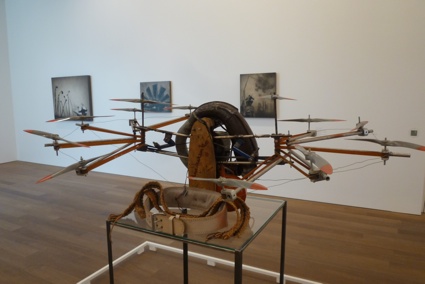 View of one of the exhibition rooms (Panamarenko and Robert & Shana ParkeHarrison)
View of one of the exhibition rooms (Panamarenko and Robert & Shana ParkeHarrison)
Leonardo da Vinci pretty much leaves everyone in the shadow when it comes to embodying the figure of the artist as inventor (or maybe vice versa.) But he has a few heirs among contemporary artists. First in the line is Panamarenko. Just like the Italian polymath, Panamarenko’s flying machines and prosthesis trigger the question “But do they fly?” The answer might not matter, the contraptions owe as much to the artist’s curiosity for natural phenomenon and technology as they do to the tragic mythological Athenian Icarus.
Knikkebeen, a bipedal prosthesis inspired by the camel’s gait.
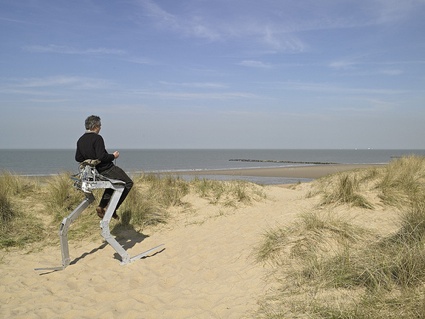 Panamarenko, Knikkebeen, 2011, Courtesy Mulier Mulier, Knokke-Le-Zoute © Panamarenko
Panamarenko, Knikkebeen, 2011, Courtesy Mulier Mulier, Knokke-Le-Zoute © Panamarenko
Many of his experimental flying machines were modeled on the motion of birds and insects:
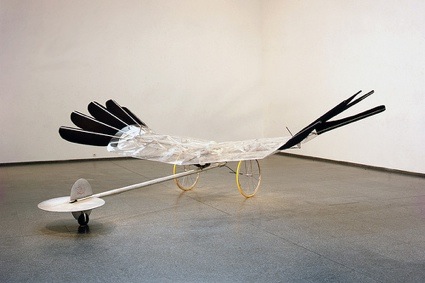 Panamarenko, Raven’s Variable Matrix, 2000
Panamarenko, Raven’s Variable Matrix, 2000
In the 1970s, Czech filmmaker Jan Švankmajer drew extraordinary plans of coin-operated artificial vagina and penis, complete with a detailed user manual. The Masturbation Machines come with hydraulic pistons that generate an ‘up-and-down movement’, a set of cartridges of ‘ejaculate’ substance, a disinfection system for the vagina, ventilators to drive away flying insects in the Summer months, an audiotape emitting suitable gasps and sighs, etc.
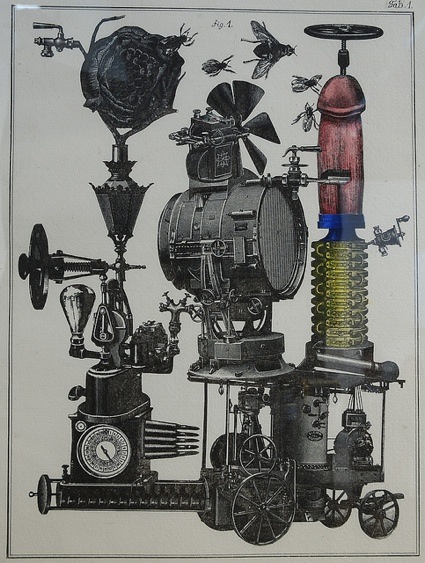 Jan Švankmajer, Cycle Masturbation Machines, 1972-1973
Jan Švankmajer, Cycle Masturbation Machines, 1972-1973
Implemented by the State, these Masturbation Machines would ensure a satisfied workforce more able to focus on labor during working hours, a more harmonious family, less risks of sexually-transmitted diseases, a decrease in sexual crime, a democratization of sex and a complete state control over the sexuality of its citizens.
A few steps away from the drawings, Paul Granjon’s gendered robots were mating and sniffing each other with gusto in their little ‘Robotarium” enclosure.
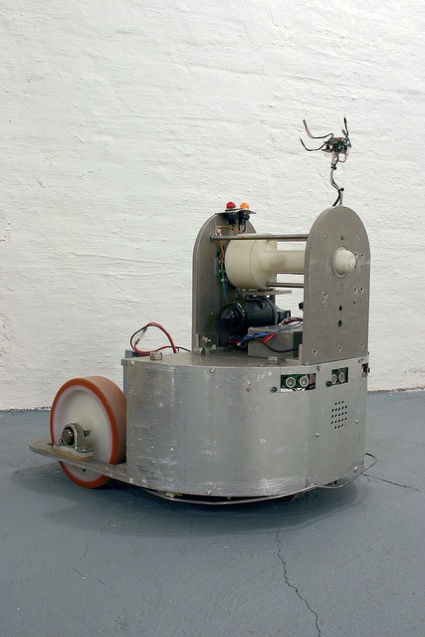 Paul Granjon, Robots sexués, 2005
Paul Granjon, Robots sexués, 2005
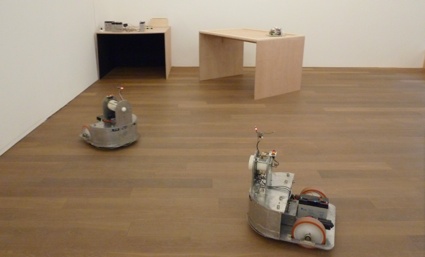 Paul Granjon, Robots sexués, 2005
Paul Granjon, Robots sexués, 2005
A second group of artworks attempt to understand and reproduce physical phenomena or natural forces.
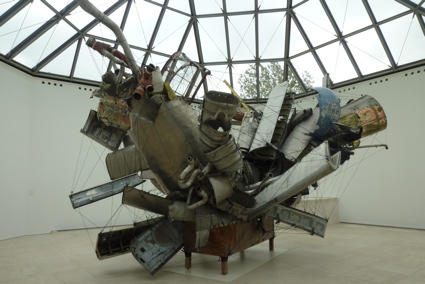 Nancy Rubins, Table and Airplane Parts, 1990
Nancy Rubins, Table and Airplane Parts, 1990
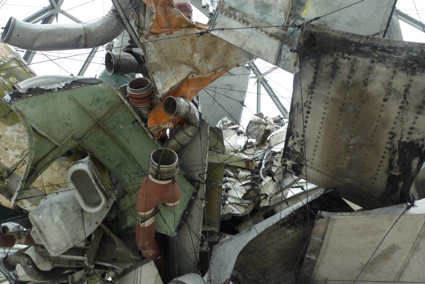 Nancy Rubins, Table and Airplane Parts (detail), 1990
Nancy Rubins, Table and Airplane Parts (detail), 1990
Nancy Rubins‘s Table and Airplane Parts is exactly what its title says: an accumulation of airplane parts on a sturdy wooden table. Some of them seem to have crashed into the piece of furniture, while other parts are resting on it. Bits of the reactor, of wings, doors, of the cockpit and fuselage are tangled up in an almost implausible challenge of balance.
Just like the planes that fly up our heads, the work defies gravity.
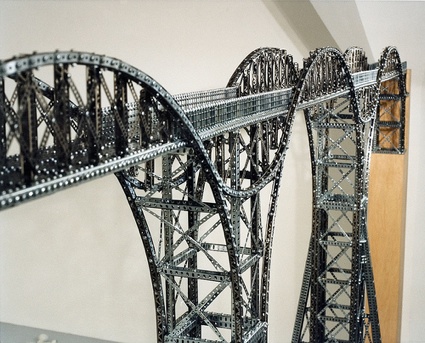 Chris Burden,The Mexican Bridge,1998
Chris Burden,The Mexican Bridge,1998
Chris Burden’s Mexican Bridge celebrates engineering as well, albeit in a less tumultuous way. He discovered this bridge in the book Railroads in Mexico. It was and remained a drawing as the bridge was never built.
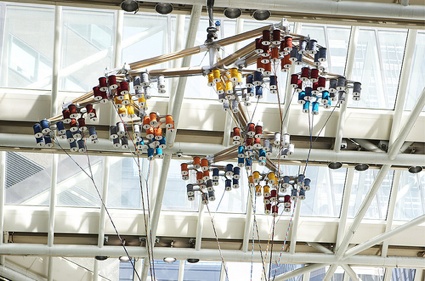 Conrad Shawcross, The Nervous System [Inverted], 2011
Conrad Shawcross, The Nervous System [Inverted], 2011
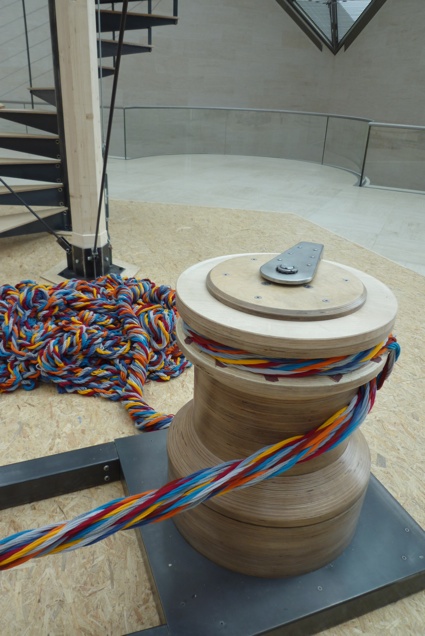 Conrad Shawcross, The Nervous System [Inverted], 2011
Conrad Shawcross, The Nervous System [Inverted], 2011
Visitor are invited to climb up the helicoidal stairs that surround Conrad Shawcross‘s The Nervous System (Inverted) and see its every detail from up close. The machine weaves spools of thread into a multi-colored rope that slowly drops to the ground. The towering artwork reveals the beauty of forces in action in large-scale technological installations of the industrial age.
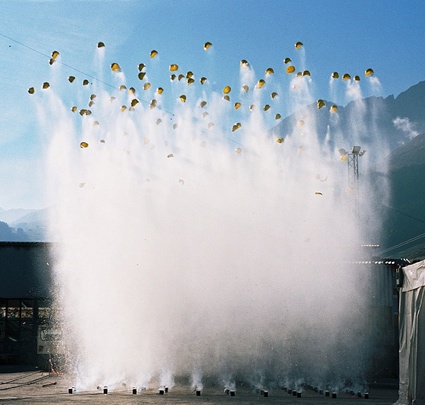 Roman Signer, Aktion in Sedrun, 2010
Roman Signer, Aktion in Sedrun, 2010
Roman Signer‘s videos appear in half of the exhibitions i’m visiting these days but i never get tired of them. For his Action in Sedrun, he fired 100 protective helmets into the air in honour of the workers at the breakthrough of the Gotthard base tunnel, in the Swiss Alps.
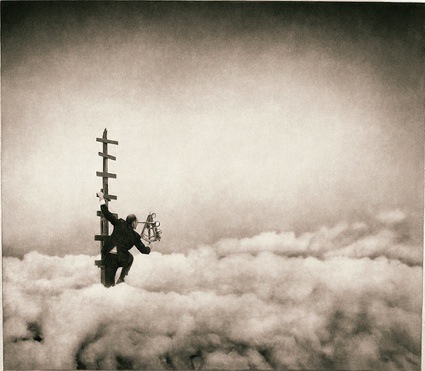 Robert & Shana ParkeHarrison, The Navigator, 2001, Courtesy galerie Jack Shainman, New York © Robert & Shana ParkeHarrison
Robert & Shana ParkeHarrison, The Navigator, 2001, Courtesy galerie Jack Shainman, New York © Robert & Shana ParkeHarrison
Robert & Shana ParkeHarrison‘s sepia-toned photos deliberately look artificial. The landscape the main character inhabit is desolate and barren like in your worst post-apocalyptic nightmares. Yet the man at the center of the scene tirelessly gets to grip with what the damage done to the land by, we are guessing, its previous inhabitants. Armed with extravagant and impractical equipment, he’s sowing, planting, manufacturing clouds, etc.
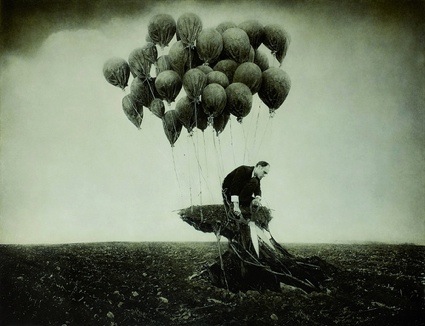 Robert & Shana ParkeHarrison, Suspended Field, From the series Kingdom, 2000
Robert & Shana ParkeHarrison, Suspended Field, From the series Kingdom, 2000
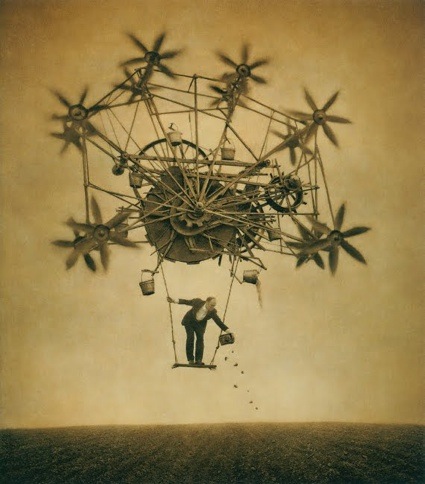 Robert & Shana ParkeHarrison, The Sower, 2001
Robert & Shana ParkeHarrison, The Sower, 2001
There’s so much more to see in the MUDAM show: a documentary on Theo Jansen, many many more absurd videos by Roman Signer, Björn Dahlem questioning cosmology using alarm clocks, Paul Lafolley’s belief in mystical science put on paper, etc. I can’t recommend that exhibition enough. The selection of artworks, the space left for each of them to breathe, the seducing combination of humour and science make it one of the best shows i’ve seen this Autumn.
Mondes inventés, Mondes habités remains open at MUDAM in Luxembourg through 15th January 2012.
